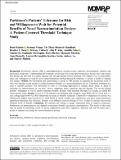Parkinson’s Patients’ Tolerance for Risk and Willingness to Wait for Potential Benefits of Novel Neurostimulation Devices: A Patient-Centered Threshold Technique Study
Author(s)
Hauber, Brett; Mange, Brennan; Zhou, Mo; Chaudhuri, Shomesh; Benz, Heather L; Caldwell, Brittany; Ruiz, John P; Saha, Anindita; Ho, Martin; Christopher, Stephanie; Bardot, Dawn; Sheehan, Margaret; Donnelly, Anne; McLaughlin, Lauren; Gwinn, Katrina; Lo, Andrew; Sheldon, Murray; ... Show more Show less
DownloadPublished version (968.9Kb)
Publisher with Creative Commons License
Publisher with Creative Commons License
Creative Commons Attribution
Terms of use
Metadata
Show full item recordAbstract
© The Author(s) 2021. Background. Parkinson’s disease (PD) is neurodegenerative, causing motor, cognitive, psychological, somatic, and autonomic symptoms. Understanding PD patients’ preferences for novel neurostimulation devices may help ensure that devices are delivered in a timely manner with the appropriate level of evidence. Our objective was to elicit preferences and willingness-to-wait for novel neurostimulation devices among PD patients to inform a model of optimal trial design. Methods. We developed and administered a survey to PD patients to quantify the maximum levels of risks that patients would accept to achieve potential benefits of a neurostimulation device. Threshold technique was used to quantify patients’ risk thresholds for new or worsening depression or anxiety, brain bleed, or death in exchange for improvements in “on-time,” motor symptoms, pain, cognition, and pill burden. The survey elicited patients’ willingness to wait to receive treatment benefit. Patients were recruited through Fox Insight, an online PD observational study. Results. A total of 2740 patients were included and a majority were White (94.6%) and had a 4-year college degree (69.8%). Risk thresholds increased as benefits increased. Threshold for depression or anxiety was substantially higher than threshold for brain bleed or death. Patient age, ambulation, and prior neurostimulation experience influenced risk tolerance. Patients were willing to wait an average of 4 to 13 years for devices that provide different levels of benefit. Conclusions. PD patients are willing to accept substantial risks to improve symptoms. Preferences are heterogeneous and depend on treatment benefit and patient characteristics. The results of this study may be useful in informing review of device applications and other regulatory decisions and will be input into a model of optimal trial design for neurostimulation devices.
Date issued
2021Department
Massachusetts Institute of Technology. Department of Mechanical Engineering; Sloan School of ManagementJournal
MDM Policy and Practice
Publisher
SAGE Publications
Citation
Hauber, Brett, Mange, Brennan, Zhou, Mo, Chaudhuri, Shomesh, Benz, Heather L et al. 2021. "Parkinson’s Patients’ Tolerance for Risk and Willingness to Wait for Potential Benefits of Novel Neurostimulation Devices: A Patient-Centered Threshold Technique Study." MDM Policy and Practice, 6 (1).
Version: Final published version